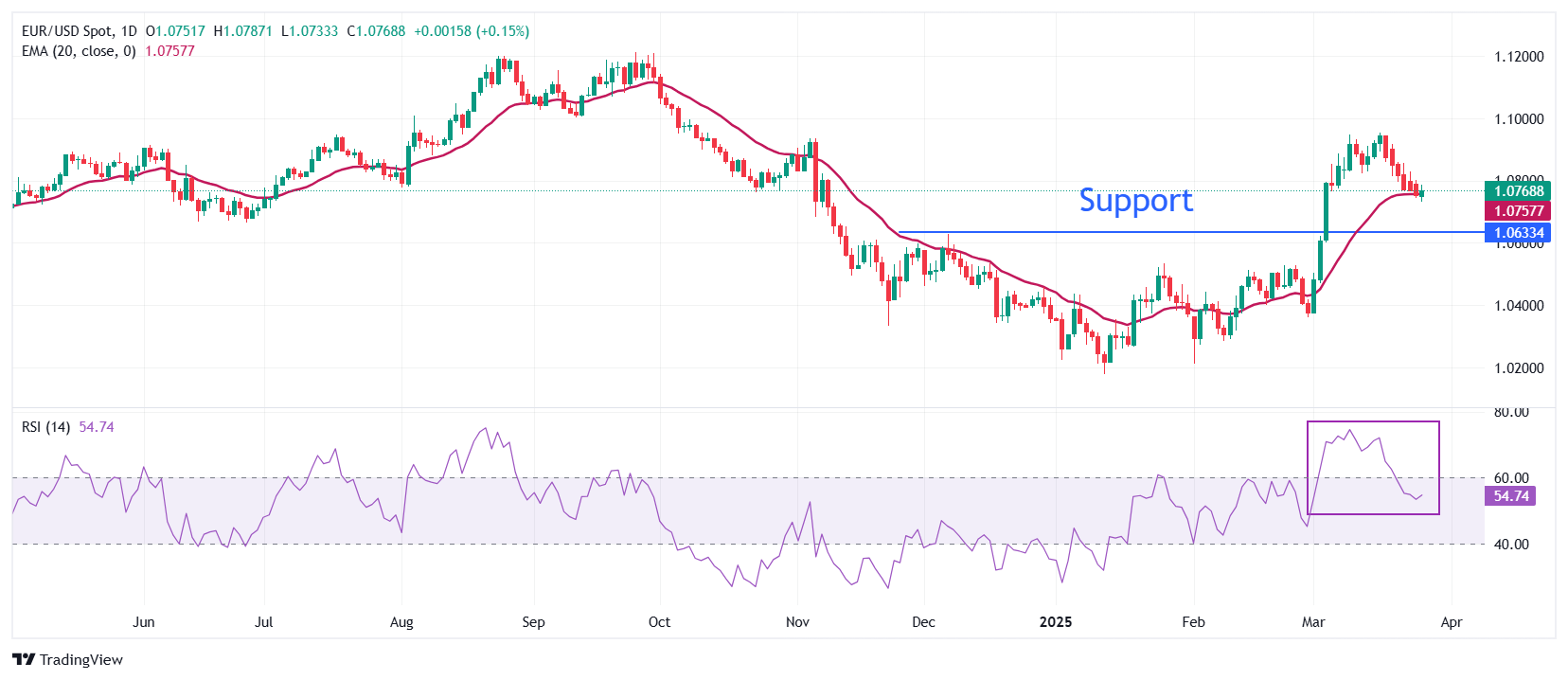EUR/USD recovers despite Trump threatening large-scale tariffs on Eurozone
- EUR/USD rebounds to near 1.0780 as the US Dollar corrects despite US President Trump threatening to impose large-scale tariffs on the Eurozone and Canada.
- Trump has imposed a 25% levy on imports of all automobiles and auto components.
- Investors await the US PCE inflation data, which will be released on Friday.
EUR/USD trades higher around 1.0770 in European trading hours on Thursday. The major currency pair gains after a six-day losing streak as the US Dollar Index (DXY) retraces from its three-week high of 104.65. The outlook for the Euro (EUR) turns fragile as United States (US) President Donald Trump has threatened to impose large-scale tariffs on Canada and the Eurozone for devising plans to harm the US economy.
“If the European Union (EU) works with Canada in order to do economic harm to the USA, large scale tariffs, far larger than currently planned, will be placed on them both in order to protect the best friend that each of those two countries has ever had,” Trump said in a post on Truth Social.
The scenario has prompted fears of a frightful trade war between the Eurozone and the US, which would result in an economic slowdown in both countries.
After Trump’s large-scale tariff threats, European Central Bank (ECB) policymaker and Belgian central bank Governor Pierre Wunsch said in his CNBC interview that tariffs would be bad for economic growth and boost inflationary pressures. “Inflation risks might be on the upside,” Wunsch said, but he ruled out the likelihood of an interest rate hike this year. Wunsch added, “a rate-cut pause in April should be on the table.” On the contrary, traders have become increasingly confident that the ECB could reduce interest rates again in April’s meeting amid deepening economic risks from the Trump-led tariff war.
Earlier in the day, Donald Trump announced 25% tariffs on imports of automobiles and auto-components, which will come into effect on April 2. The German economy will be one of the major victims of the Trump’s tariffs on automobiles as it dispatches 13% of its total auto exports to the US.
Daily digest market movers: EUR/USD rebounds at the US Dollar’s expense
- EUR/USD rebounds after correcting in the last six trading sessions. The pair attracts bids as the US Dollar (USD) corrects despite US President Donald Trump imposing tariffs on auto imports. Market participants expect that the impact of Trump’s levies agenda will also be unfavorable for the domestic economy in the near term.
- The impact of costly products entering the US will be borne by importers who would have no other option than to pass them on to consumers. Such a scenario will be inflationary for the economy, which would dampen the purchasing power of households.
- Trump’s tariff policies have complicated the Federal Reserve’s (Fed) job. The Fed would be in a balancing act, as the possibility of higher inflation could force the central bank to maintain a restrictive monetary policy stance, and fears of slower economic growth prompt the need for an expansionary policy. Minneapolis Fed Bank President Neel Kashkari said at the Detroit Lakes Chamber Economic Summit on Wednesday that together, those forces are "kind of a wash”. He guided that the Fed should "just sit where we are for an extended period of time until we get clarity."
- According to the CME FedWatch tool, the Fed is certain to keep interest rates steady in the current range of 4.25%-4.50% in the May policy meeting but see a 65.5% chance of a reduction in June.
- Going forward, the major trigger for the US Dollar will be the US Personal Consumption Expenditure Price Index (PCE) data for February, which will be released on Friday. Economists expect the US core PCE inflation, which is the Fed’s preferred inflation gauge, to have grown at a faster pace of 2.7% year-on-year, compared to the 2.6% increase seen in January.
Technical Analysis: EUR/USD finds cushion after refreshing three-week low near 1.0730

EUR/USD attracts bids after posting a fresh three-week low near 1.0730, which coincided with the 20-day Exponential Moving Average (EMA) earlier in the day.
The 14-day Relative Strength Index (RSI) cools down below 60.00, suggesting that the bullish momentum is over, but the upside bias remains intact.
Looking down, the December 6 high of 1.0630 will act as the major support zone for the pair. Conversely, the psychological level of 1.1000 will be the key barrier for the Euro bulls.
Euro FAQs
The Euro is the currency for the 19 European Union countries that belong to the Eurozone. It is the second most heavily traded currency in the world behind the US Dollar. In 2022, it accounted for 31% of all foreign exchange transactions, with an average daily turnover of over $2.2 trillion a day. EUR/USD is the most heavily traded currency pair in the world, accounting for an estimated 30% off all transactions, followed by EUR/JPY (4%), EUR/GBP (3%) and EUR/AUD (2%).
The European Central Bank (ECB) in Frankfurt, Germany, is the reserve bank for the Eurozone. The ECB sets interest rates and manages monetary policy. The ECB’s primary mandate is to maintain price stability, which means either controlling inflation or stimulating growth. Its primary tool is the raising or lowering of interest rates. Relatively high interest rates – or the expectation of higher rates – will usually benefit the Euro and vice versa. The ECB Governing Council makes monetary policy decisions at meetings held eight times a year. Decisions are made by heads of the Eurozone national banks and six permanent members, including the President of the ECB, Christine Lagarde.
Eurozone inflation data, measured by the Harmonized Index of Consumer Prices (HICP), is an important econometric for the Euro. If inflation rises more than expected, especially if above the ECB’s 2% target, it obliges the ECB to raise interest rates to bring it back under control. Relatively high interest rates compared to its counterparts will usually benefit the Euro, as it makes the region more attractive as a place for global investors to park their money.
Data releases gauge the health of the economy and can impact on the Euro. Indicators such as GDP, Manufacturing and Services PMIs, employment, and consumer sentiment surveys can all influence the direction of the single currency. A strong economy is good for the Euro. Not only does it attract more foreign investment but it may encourage the ECB to put up interest rates, which will directly strengthen the Euro. Otherwise, if economic data is weak, the Euro is likely to fall. Economic data for the four largest economies in the euro area (Germany, France, Italy and Spain) are especially significant, as they account for 75% of the Eurozone’s economy.
Another significant data release for the Euro is the Trade Balance. This indicator measures the difference between what a country earns from its exports and what it spends on imports over a given period. If a country produces highly sought after exports then its currency will gain in value purely from the extra demand created from foreign buyers seeking to purchase these goods. Therefore, a positive net Trade Balance strengthens a currency and vice versa for a negative balance.


